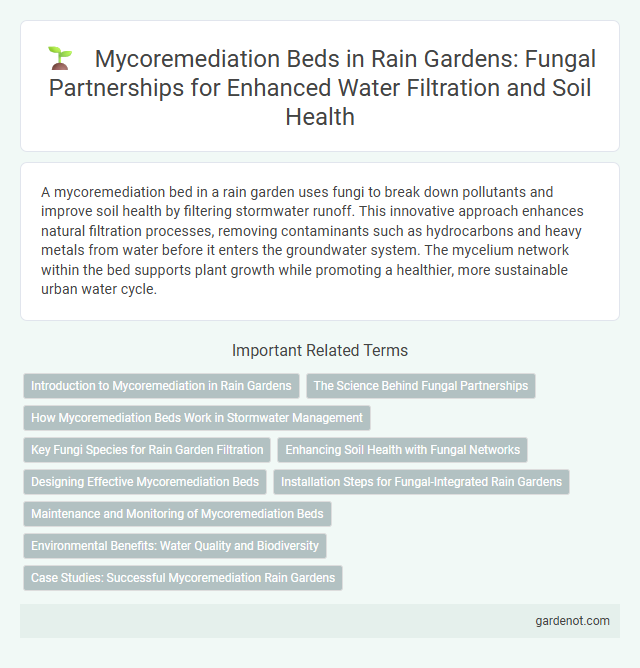A mycoremediation bed in a rain garden uses fungi to break down pollutants and improve soil health by filtering stormwater runoff. This innovative approach enhances natural filtration processes, removing contaminants such as hydrocarbons and heavy metals from water before it enters the groundwater system. The mycelium network within the bed supports plant growth while promoting a healthier, more sustainable urban water cycle.
Introduction to Mycoremediation in Rain Gardens
Mycoremediation in rain gardens utilizes fungi to break down pollutants and enhance soil health, improving water filtration and reducing contaminants in stormwater runoff. The fungal mycelium acts as a natural biofilter, decomposing organic matter and absorbing heavy metals and toxins. Integrating mycoremediation beds within rain gardens supports sustainable water management by promoting cleaner runoff and healthier ecosystems.
The Science Behind Fungal Partnerships
Mycoremediation beds leverage fungal networks to break down pollutants in rain gardens, enhancing soil and water purification through enzyme-driven biodegradation. Fungi form symbiotic relationships with plant roots, exchanging nutrients and boosting microbial activity that decomposes contaminants such as hydrocarbons and heavy metals. This fungal partnership accelerates pollutant absorption and supports sustainable stormwater management by improving soil health and reducing runoff toxicity.
How Mycoremediation Beds Work in Stormwater Management
Mycoremediation beds utilize fungi to treat stormwater by breaking down pollutants such as hydrocarbons, heavy metals, and organic waste through enzymatic processes. The fungal mycelium acts as a natural filtration system, absorbing and degrading contaminants while enhancing soil structure and moisture retention. This biological treatment method improves water quality and reduces the burden on traditional stormwater infrastructure by promoting natural detoxification and infiltration.
Key Fungi Species for Rain Garden Filtration
Mycoremediation beds in rain gardens utilize key fungi species such as Pleurotus ostreatus (oyster mushroom) and Trametes versicolor (turkey tail) for effective filtration and pollutant breakdown. These fungi possess enzymatic capabilities to degrade heavy metals, hydrocarbons, and organic contaminants, enhancing water purification. Incorporating these species optimizes the biodegradation process, improving the rain garden's ability to manage stormwater runoff and reduce environmental toxins.
Enhancing Soil Health with Fungal Networks
Mycoremediation beds leverage fungal networks to significantly enhance soil health by breaking down organic pollutants and improving nutrient cycling. The symbiotic relationships formed by mycelium increase soil aeration and moisture retention, fostering robust plant growth within rain gardens. Integrating fungal mycelia in rain garden beds supports biodegradation processes, promoting sustainable ecosystem restoration and water quality improvements.
Designing Effective Mycoremediation Beds
Designing effective mycoremediation beds requires selecting appropriate fungal species known for their ability to degrade pollutants commonly found in stormwater runoff. Incorporating a layered substrate composed of organic matter, wood chips, and soil enhances fungal growth and pollutant absorption. Optimizing moisture levels and aeration supports mycelium development, increasing the biodegradation efficiency of contaminants in rain garden environments.
Installation Steps for Fungal-Integrated Rain Gardens
Installing a mycoremediation bed in a fungal-integrated rain garden begins with selecting a suitable site that ensures proper water flow and drainage. Incorporate layers of organic mulch, wood chips, and selected fungal spawn such as oyster mushrooms (Pleurotus ostreatus) to enhance pollutant breakdown and soil health. Maintain optimal moisture levels and aeration to support fungal colonization, improving the rain garden's capacity to filter contaminants and promote ecosystem restoration.
Maintenance and Monitoring of Mycoremediation Beds
Regular maintenance of mycoremediation beds involves inspecting fungal health, removing debris, and ensuring proper moisture levels to optimize pollutant breakdown. Monitoring soil chemistry and microbial activity helps track the effectiveness of the mycelium in degrading contaminants. Periodic assessment of plant vitality supports overall ecosystem balance and maximizes bioremediation performance.
Environmental Benefits: Water Quality and Biodiversity
Mycoremediation beds in rain gardens utilize fungi to break down pollutants, significantly improving water quality by filtering contaminants such as heavy metals and hydrocarbons. This process enhances soil health and promotes microbial diversity, fostering a balanced ecosystem. The increased biodiversity supports native plants and wildlife, contributing to the overall resilience and sustainability of urban green spaces.
Case Studies: Successful Mycoremediation Rain Gardens
Mycoremediation rain gardens utilize fungi to break down contaminants in stormwater, enhancing pollutant removal efficiency in urban environments. Case studies such as the one in Portland, Oregon demonstrated a 70% reduction in heavy metals and hydrocarbons within six months using mycelium-enhanced soil beds. Another successful implementation in Toronto showed improved nitrogen and phosphorus absorption, significantly reducing nutrient runoff into local waterways.
Mycoremediation bed Infographic

 gardenot.com
gardenot.com